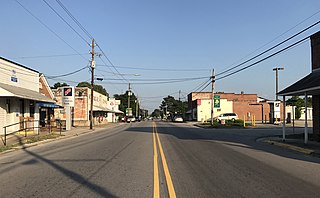
Bunn is a town in Franklin County, North Carolina, United States. The population was 327 at the 2020 census.
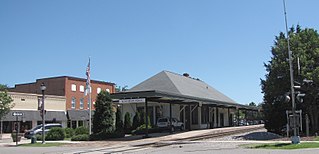
Southern Pines is a town in Moore County, North Carolina, United States. The population was 12,334 as of the 2010 United States Census.

The Thomas Wolfe House, also known as the Thomas Wolfe Memorial, is a state historic site, historic house and museum located at 52 North Market Street in downtown Asheville, North Carolina. The American author Thomas Wolfe (1900–1938) lived in the home during his boyhood. The house was designated a National Historic Landmark in 1971 for its association with Wolfe. It is located in the Downtown Asheville Historic District.

The Orton Plantation is a historic plantation house in the Smithville Township of Brunswick County, North Carolina, United States. Located beside the Cape Fear River between Wilmington and Southport, Orton Plantation is considered to be a near-perfect example of Southern antebellum architecture. Built in 1735 by the co-founder of Brunswick Town, Colonel Maurice Moore, the Orton Plantation house is one of the oldest structures in Brunswick County. During its history Orton Plantation has been attacked by Native Americans, used as a military hospital, and been home to lawyers, physicians, military leaders, and a Colonial governor.

Everhope, known throughout most of its history as the Captain Nathan Carpenter House and more recently as Twin Oaks Plantation, is a historic plantation house near Eutaw, Alabama. Completed in 1853 for Nathan Mullin Carpenter, it is listed on the National Register of Historic Places and Alabama Register of Landmarks and Heritage due to its architectural and historical significance.

Woodburn or the Woodburn Plantation is an antebellum house near Pendleton in Anderson County, South Carolina. It is at 130 History Lane just off of U.S. 76. It was built as a summer home by Charles Cotesworth Pinckney. Woodburn was named to the National Register of Historic Places on May 6, 1970. It also is part of the Pendleton Historic District.
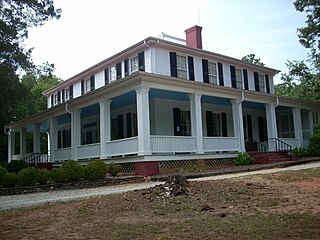
Ashtabula is a plantation house at 2725 Old Greenville Highway near Pendleton in Anderson County, South Carolina, USA. It has been also known as the Gibbes-Broyles-Latta-Pelzer House or some combination of one or more of these names. It was named in the National Register of Historic Places as a historic district on March 23, 1972. It is considered a significant example of a Lowcountry style plantation house built for a Charleston family in the Upstate in the early 19th century. It also is part of the Pendleton Historic District.

The House in the Horseshoe, also known as the Alston House, is a historic house in Glendon, North Carolina in Moore County, and a historic site managed by the North Carolina Department of Natural and Cultural Resources' Historic Sites division. The home, built in 1772 by Philip Alston, was the site of a battle between loyalists under the command of David Fanning and patriot militiamen under Alston's command on either July 29 or August 5, 1781. The battle ended with Alston's surrender to Fanning, in which Alston's wife negotiated the terms with the loyalists.

The Franklin Pierce Cover House is a historic house on North Carolina Route 1388 in the small town of Andrews, North Carolina. The 2+1⁄2-story brick Queen Anne Victorian was built in 1900, and is a remnant of Andrews' industrial heritage. The house was built by Franklin Pierce Cover, owner of a local tannery. It exhibits the complex massing typical of Queen Anne houses, with multiple gables, projections, and a massive three-story octagonal tower. Documentary photographs suggest the house once had a Queen Anne porch with brackets and an ornamental frieze, but this was replaced by a more Colonial Revival scheme with heavier Tuscan columns.

Walker's Inn is a historic building in rural Cherokee County, North Carolina. It is located at the northeast corner of the junction of SR 1505 and SR 1383 near Andrews. The house, appearing as a two-story five-bay frame house, was apparently built in stages, beginning c. 1844, after William Walker acquired the land on which it stands. The three rightmost bays of the house are a log structure, while the two on the left are a frame structure. The logs are partially exposed on the front, while most of the house is sheathed in board-and-batten siding. Windows are irregularly placed on the main facade. Long known as an inn, it sits along what was in the 19th century the major route between Franklin and Murphy. Frederick Law Olmsted stayed at the inn during his travels in the area in the late 19th century.

Franklin-Penland House, also known as Theodore C. Franklin House, Stokes Penland House, and Linville Falls Post Office, is a historic home located at Linville Falls, Burke County, North Carolina. It was built about 1883, and is a two-story, three-bay, frame I-house with a two-story rear ell. It features a full-width, attached two-tiered shed roof porch added about 1915. Also on the property is the former U.S. Post Office, Linville Falls, N.C., building. The one-room front gable frame building was built in 1907 and housed the Linville Falls post office until 1925.

Franklin Pierce Tate House is a historic home located at Morganton, Burke County, North Carolina. It was designed by architect Electus D. Litchfield and completed in 1928. It is a two-story, Colonial Revival style dwelling constructed of irregularly-coursed, rock-faced granite blocks.
Franklin D. Reinhardt and Harren–Hood Farms, also known as the Franklin D. Reinhardt Farm and Alonzo Harren Farm, is a set of two adjoining historic farms and national historic district located near Maiden, Catawba County, North Carolina. The district encompasses 5 contributing buildings and 1 contributing site. The Franklin D. Reinhardt House was built about 1845, and is a two-story, Greek Revival style dwelling nearly identical to the William Pinckney Reinhardt House. Also on the property is a contributing granary. The Harren-Hood House was built about 1908, and is a two-story frame, late Victorian farmhouse. Also on the property is a contributing granary and cattle barn.

Robert Joseph Moore House is a historic home located at Bynum, Chatham County, North Carolina. It was built in 1929, and is a two-story, four-square, brick dwelling with a brick foundation and a low pyramidal roof with Colonial Revival and American Craftsman design elements. Also on the property are the contributing garage and barn.

The Andrews-Duncan House is a historic building located at 407 North Blount Street in Raleigh, North Carolina, United States. Built in 1874 for a prominent businessman, the Italianate style home was designed by architect George S. H. Appleget. The house was added to the National Register of Historic Places (NRHP) in 1972 and is currently owned by the state government. A large tree named after a presidential candidate once stood behind the house and is commemorated with a historical marker.
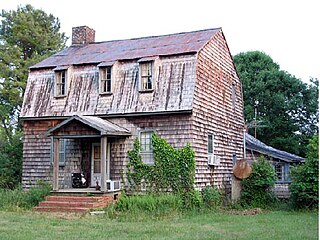
Shemuel Kearney House was a historic plantation house located near Franklinton, Franklin County, North Carolina, formerly at 2555 U.S. Highway 1 south of town. In 2009, the house was dismantled and moved to nearby Louisburg for restoration as the original property was recently zoned by Franklin County for commercial use. Therefore, the building had to be relocated. The Shemuel Kearney House was reconstructed next to another historic residence, the Cooke House, on Peach Orchard Road in 2015.
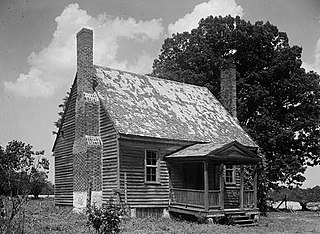
Cascine is a historic plantation complex and national historic district located near Louisburg, Franklin County, North Carolina. The district encompasses 12 contributing buildings, 4 contributing sites, and 3 contributing structures. The main house was built about 1850, and is a large two-story, Greek Revival style frame dwelling, in the manner of Jacob W. Holt, with Gothic Revival style influences. Also on the property is a small, one-story frame dwelling dated to about 1752. It was repaired and refurbished in the mid-20th century. Also on the property are the contributing brick kitchen, frame stable, granary, carriage house, family cemetery, slave cemetery, remains of slave quarters, tenant house, six log and frame tobacco barns, grist mill complex, and archaeological sites.
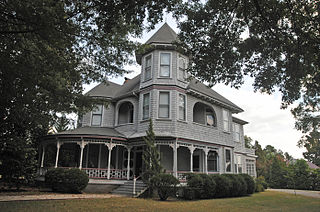
J.C. Black House is a historic home located at Carthage, Moore County, North Carolina. It was built in 1893, and is a large two-story, rectangular Queen Anne style frame dwelling. It sits on a brick foundation and has a hipped roof. It features a three-story, polygonal corner tower, recessed balcony, round two-story bay, and a front porch with decorative sawnwork, turned brackets, and a spindle frieze. Also on the property is a contributing fanciful, polygonal well house.

TheMichael Braun House is a historic Colonial stone house located near Granite Quarry, Rowan County, North Carolina, United States. It is the oldest known dwelling in Rowan County and one of the oldest in Piedmont North Carolina.
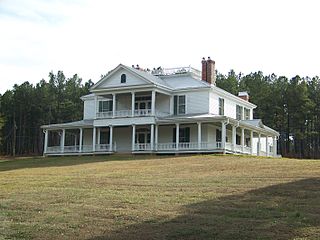
Carson-Andrews Mill and Ben F.W. Andrews House, also known as Andrews Mill, is a historic home and grist mill located near Washburn, Rutherford County, North Carolina. The Carson-Andrews Mill was built between about 1830 and 1835, and is a two-story-with-attic heavy timber frame grist mill. Operation of the mill ceased in the early 1930s. The Ben F. W. Andrews House was built between about 1904 and 1908, and is a two-story, Colonial Revival style frame dwelling with a one-story rear ell. It features a pedimented, two-tier center-bay porch with one-story wraparound sections. Other contributing resources are the landscaped grounds, water wheel and stone mount (1897), flower house, and privy.























